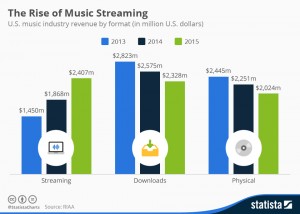5/2/16
English
Prof. Pappas
Is Technology Bad For The Music Industry?
By Michael Aylward
The music industry has changed drastically over the last 20 years, with the fall of cassettes, the rise of CDs, followed by the digital format. While some trends revive in big ways, such as the return of vinyl as a viable release method, streaming and digital purchases have become the norm in terms of consumer interest. This has opened doors for all kinds of music related services on the internet, such as Shazam, which allows a user to pull a song from an outside source and identify it, leading them to a link to purchase the song. Another popular music service is streaming, which allows users to listen to music for a subscription payment, giving them near unlimited access to all kinds of music, new and old, for a small fee. Options like Spotify, Apple Music, and Tidal have diversified what source you can pull your music from, and it has started to create a large debate on whether the near universally easy access to this music has devalued it, and whether a song can have a definitive price on it. I believe that these services allow people to make more educated decisions when it comes to purchasing music, and while it can stimulate the music industry, it has been abused, and it can be harmful to music on a economic and artistic level.
In today’s music industry, streaming has become the standard. Streaming is the ability to listen to and even download music over the internet or even from your smartphone, for a very small monthly fee. Streaming has completely changed the way that music is consumed, and consumers have begun downloading more music than ever.
According to the website Statista, over the last three years, the way music is heard has changed considerably. While streaming has increased significantly over this time, both downloads and physical copies have decreased in popularity each year. “Amounting to $2.41 billion, streaming revenues increased by almost 30 percent in 2015, offsetting the combined losses in revenue from downloads and physical format sales.” (Statista.) 30% is arguably a massive change in the landscape of music as a product, and with the trend seemingly getting bigger with each year, it appears that this is a change is something more than a trend, and will soon become the changing of a climate that has been the norm for almost a decade now.
The question is: can this devalue the art of music? From the start, music has been relatively cheap to purchase, being anywhere from 99 cents to $1.29, and most albums only cost $9.99 to $12.99. With streaming, there is a formula that gauges the payments to a label, the streaming service itself, and finally, the artist. With the amount of work that multiple people put into making a song or an album, there is a long list of payments that need to be distributed, with the artist being one of the last involved. With an already unfair practice and misuse of an artist’s work, streaming has the potential to kill careers of upcoming artists, which can decrease the amount of music being released in the first place. According to Business Insider, “Each time Spotify plays a song, your favorite singer or band gets as little as 0.6 cents, the company said. At that rate, a song would need to be played 166 times for the artist to earn $1 in royalties (100 cents divided by 0.6 = 166).” (businessinsider.com) This is not a profitable format for artists to distribute their work, this has been stated countless times already. Seemingly, the only way to counter this is the rare chance of the “smash hit” song. However, the only way to achieve this would logically be by analyzing the most recent hits in music, and taking from that, to the point of copying the work of another artist. If more and more artists were to do this, we could potentially have a surge of music that, frankly, sounds the same. This could further devalue music, with people seeing it as a formula, an assembly line to create a product that meets certain requirements in order to sell, something that music was never supposed to be about. “The reliance on data may be leading to a “clustering” of styles and a dispiriting sameness in pop music.” (The Atlantic.) This statement speaks to the creative and daring side of an artist, the very reason they are called “artists” in the first place.
Introducing new ways for people to discover new music is a great thing. It can introduce people to music they never would have heard otherwise, and if they like it or not, it is always healthy to be introduced to it. It can change the views and taste of anyone, if presented well. When all’s said and done, however, if there is no connection between easily attainable music and the incentive for an artist to create, it can create a divide, that is not healthy for the industry as a whole.
Works Cited
Edwards, Jim. “Here Is The Fantastically Tiny Amount Of Money Artists Get When Spotify Plays Their Songs.” Businessinsider.com. Business Insider, 05 Dec. 2013. Web. 01 May 2016
Richter, Felix. “Chart: The Rise of Music Streaming.” Statista.com. Statista, 29 Mar. 2016. Web. 01 May 2016.
Thompson, Derek. “The Shazam Effect.” Theatlantic.com. The Atlantic, Dec. 2014. Web. 01 May 2016.

